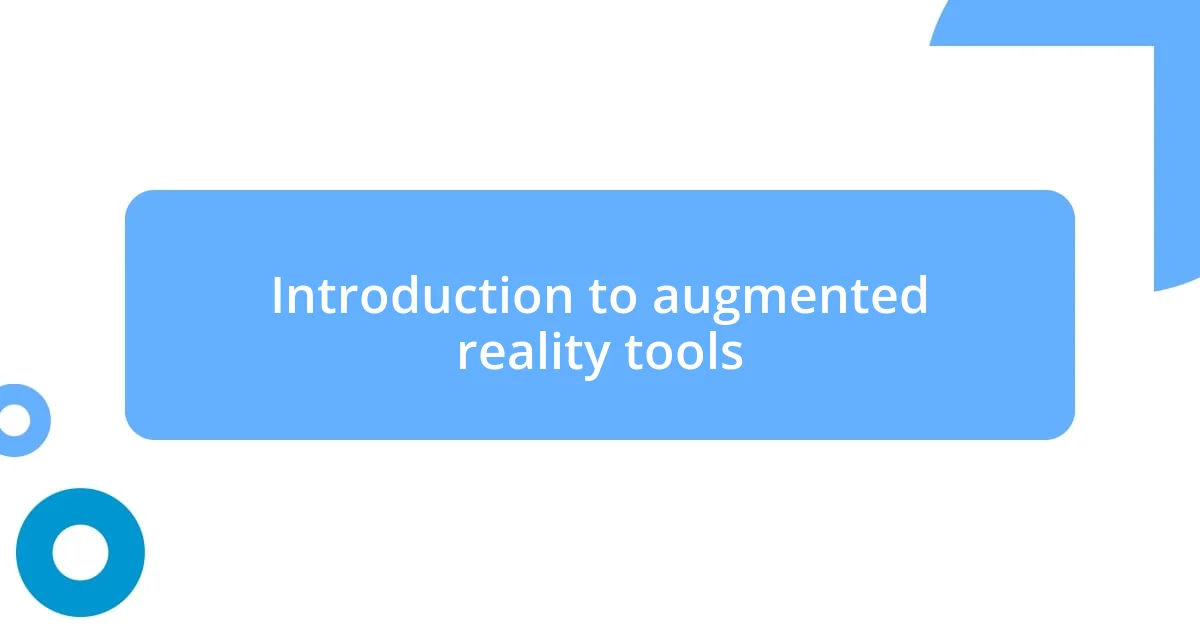Key takeaways:
- Augmented reality (AR) tools enhance real-world interactions by blending digital content, providing contextual experiences across various fields like education, healthcare, and retail.
- Key features for effective AR tools include user-friendliness, real-time tracking, compatibility across devices, and offline functionality.
- Popular AR tools such as IKEA Place, Pokémon GO, and Google Lens showcase practical applications in home design, interactive gaming, and everyday information retrieval.

Introduction to augmented reality tools
Augmented reality (AR) tools have truly transformed the way we interact with our surroundings, blending digital content with the real world. I remember the first time I used an AR app to visualize furniture in my living room; it felt like stepping into a sci-fi movie where the boundaries between reality and imagination blurred. Isn’t it fascinating how this technology allows us to overlay information or images right where we need them?
At their core, AR tools enhance our perception by providing contextually relevant information and experiences. For instance, while hiking, I once used an AR navigation tool that illuminated the surrounding trails, which helped me feel secure and informed about my journey. Have you ever wished for a personal guide who could point out hidden gems in your environment? That’s exactly what these tools offer—making the ordinary extraordinary.
Moreover, the versatility of AR tools spans across various fields, from education to entertainment, making the possibilities seem endless. Picture a classroom where students can interact with 3D models of ancient civilizations, igniting their curiosity and imagination. It’s moments like these that make me realize the immense potential AR holds—how does it make you feel to think about such advancements shaping our future?

Key features to look for
When looking for the right AR tools, several key features can significantly enhance your experience. I’ve found that intuitive user interfaces make all the difference; an app that’s easy to navigate can turn a confusing situation into a seamless exploration. In my experience, a responsive tracking system really boosts the engagement level, as it allows the virtual elements to stay anchored to the real world—remember the excitement of watching a dinosaur roam through your living room?
Consider these key features when evaluating AR tools:
- User-Friendliness: Easy navigation and controls that require minimal training.
- Real-Time Tracking: Fast and accurate tracking of movement to maintain immersion.
- Compatibility: Ability to work across various devices or platforms.
- Content Variety: A diverse library of applications, from gaming to educational tools.
- Offline Functionality: Options to work without requiring continuous internet access.
- Collaboration Features: Ability to share experiences with others in real-time.
I’ve had moments where the right tool made all the difference in sharing experiences with friends, turning a simple outing into an unforgettable journey. Imagine everyone standing together, pointing out virtual landmarks in the same environment; it feels like creating collective memories in a shared digital layer. These features really elevate the AR experience from mere novelty to something genuinely impactful.

Popular augmented reality tools available
There are numerous augmented reality tools out there that cater to various interests and professions. Some of my favorites include IKEA Place, which allows users to see how furniture fits in their space before making a purchase. I personally enjoyed reimagining my home office setup through this app; it made the design process feel more like a fun experiment rather than an arduous task. Another standout is Pokémon GO, which turned the mundane act of walking into an adventure, creating a brilliant blend of exercise and entertainment. It’s remarkable how an AR game can encourage people to explore their neighborhoods.
Additionally, Google Lens has become an essential part of my daily life. With just a tap, I can translate text, identify plants, or even discover landmarks—all through my smartphone camera. It brings an element of spontaneity to everyday encounters, sparking curiosity and learning in unexpected moments. Have you ever pointed your phone at something just to uncover its secrets? That instant gratification of newfound knowledge is incredibly rewarding.
To help you compare these popular AR tools, here’s a brief overview:
| Tool | Key Features |
|---|---|
| IKEA Place | Visualizes furniture in real space, user-friendly interface |
| Pokémon GO | Promotes outdoor activity, interactive gameplay |
| Google Lens | Text translation, object recognition, instant information |

Real-life applications of AR tools
Augmented reality tools are making waves in diverse areas like education, healthcare, and retail. I recently saw how AR can transform the classroom experience when a teacher used an AR app to bring historical events to life. Students were engaged as they interacted with 3D models of ancient artifacts, and I couldn’t help but feel that this hands-on approach makes learning so much more impactful. Who wouldn’t want to step inside a virtual Roman amphitheater while sitting in a classroom?
In healthcare, AR tools are proving invaluable for training and surgery. I read about a surgeon who used AR to overlay critical information on a patient’s anatomy during a procedure. That blend of real-time data and visualization enhances precision and could make a significant difference in patient outcomes. Can you imagine the confidence that brings to both doctors and patients alike?
Retail is another realm where AR shines. Last weekend, I wandered into a store that offered an AR fitting room experience. Instead of struggling with bulky clothing in cramped spaces, I could virtually try on outfits through an AR mirror. It felt liberating; I was free to explore a variety of styles without the clutter of conventional fitting rooms. Have you ever wished shopping could be more exciting? With AR, it’s not just about the products; it’s about crafting an interactive and enjoyable shopping journey.














